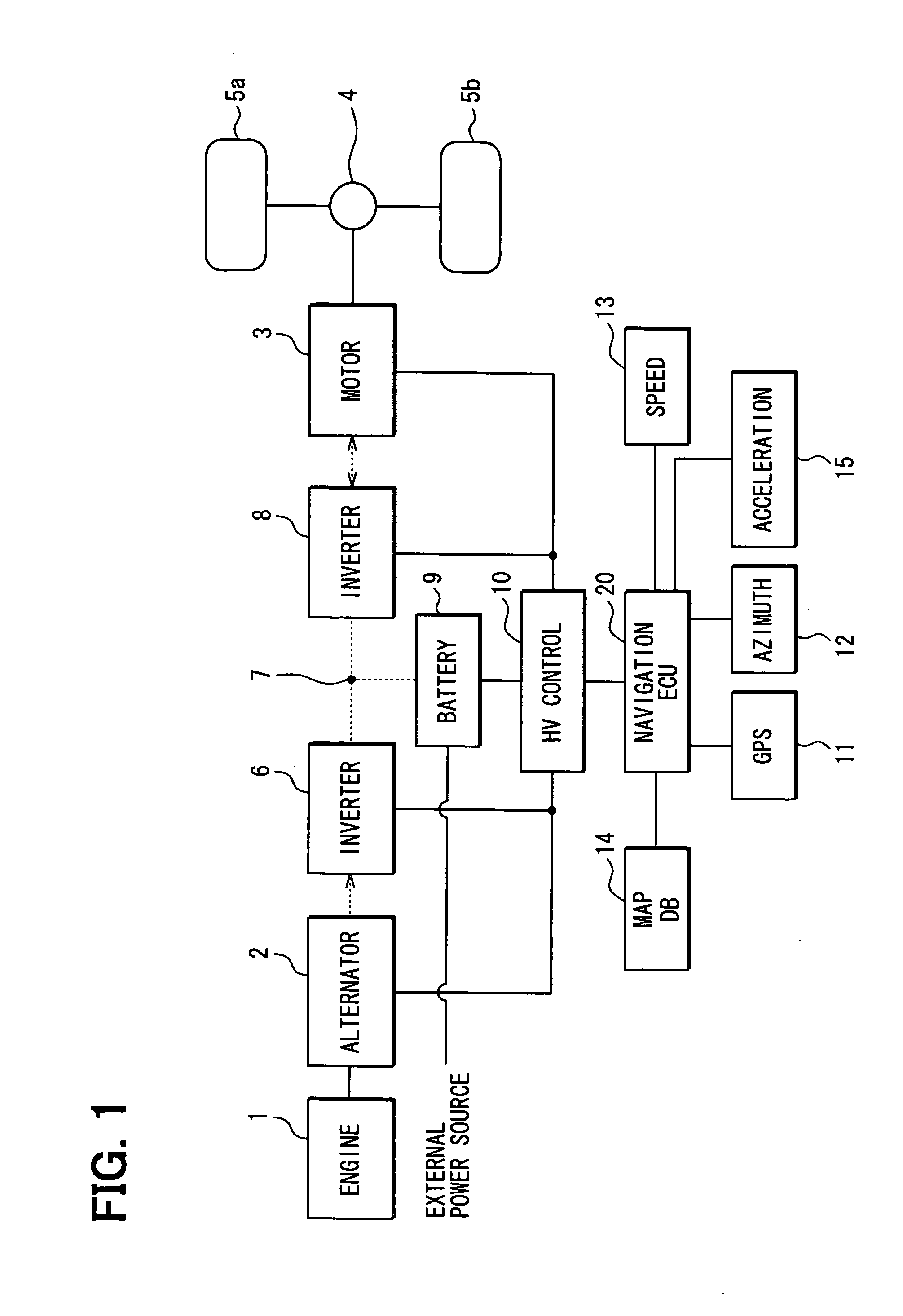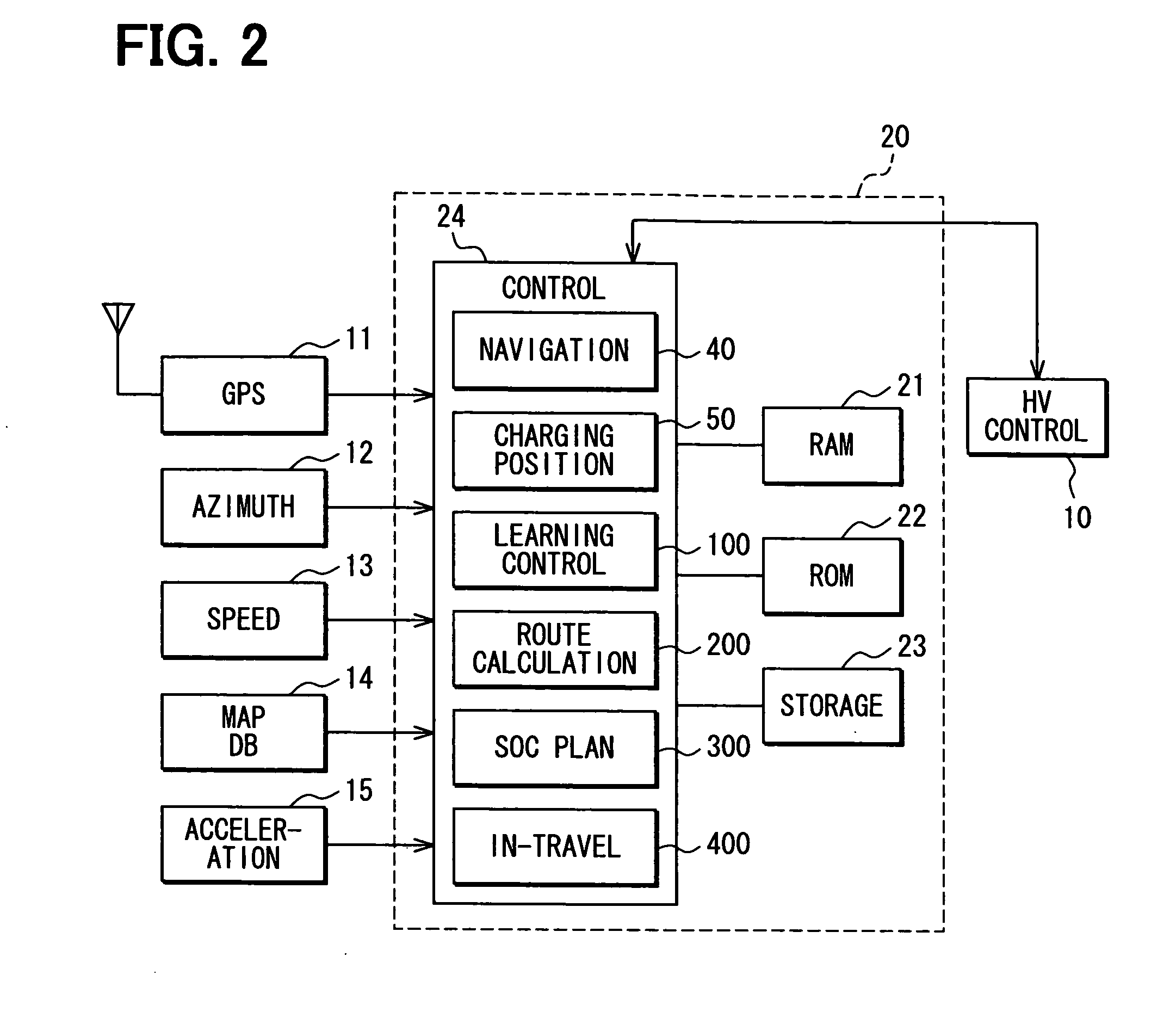Charge/discharge control apparatus for hybrid vehicle and control program device therefor
a control apparatus and hybrid technology, applied in the direction of electric devices, process and machine control, propulsion using engine-driven generators, etc., can solve the problems of reducing the traveling performance of the vehicle, difficult to realize the target amount of electric power remaining in the battery, and difficult to reduce pollution or save energy
- Summary
- Abstract
- Description
- Claims
- Application Information
AI Technical Summary
Benefits of technology
Problems solved by technology
Method used
Image
Examples
first embodiment
[0022]Referring first to FIG. 1, a hybrid vehicle has an internal combustion engine 1, an alternator 2, an electric motor 3, a differential gear 4, tires 5a, 5b, an inverter 6, a DC link 7, an inverter 8, a battery 9, an HV control unit 10, a GPS sensor 11, an azimuth sensor 12, a vehicle speed sensor 13, a map DB storage unit 14, an acceleration sensor 15 and a navigation ECU 20.
[0023]The hybrid vehicle travels using the engine 1 and the electric motor 3 as drive power sources. When the engine 1 is used as the drive power source, the rotational force of the engine 1 is transmitted to the tires 5a, 5b via a clutch mechanism (not shown) and the differential gear 4 in the known manner. When the electric motor 3 is used as the drive power source, the DC power of the battery 9 is converted into the AC power through the DC link 7 and the inverter 8, the electric motor 3 is operated by the AC power, and the rotational force of the electric motor 3 is transmitted to the tires 5a, 5b throug...
second embodiment
[0078]Next, a second embodiment is shown in FIG. 9 and different from the first embodiment with respect to the combination of the EV mode and HV mode. Specifically, in the first embodiment, the traveling mode is the HV mode over the whole sections from the start point up to the commence point of the EV finish section on the optimum route up to the destination point. In the second embodiment, as shown in FIG. 9, the traveling mode is the EV mode from a start point 91 up to a given point (end point) 92 among the sections from the start point 91 up to a commence point 93 of the EV finish section, and the traveling mode is the HV mode from the end point 92 up to the commence point 93 of the EV finish section.
[0079]To realize the above operation, the control unit 24 in the SOC management plan preparation processing 300 calculates the amount of battery power consumption when the EV mode is used over a section continuing along the optimum route from the start point 91 on the optimum route ...
third embodiment
[0084]Next, a third embodiment is shown in FIGS. 10 and 11. This embodiment is different from the first embodiment in that the control unit 24 in executes an in-travel processing 4000 shown in FIG. 10 instead of the in-travel processing 400 (FIG. 8). The in-travel processing 4000 is different from the in-travel processing 400 in that an exception processing of step 455 is executed between step 454 and step 460. The exception processing is for checking whether it has become necessary to change the SOC management plan and for preparing the SOC management plan again if it has become necessary.
[0085]In the exception processing 455 shown in FIG. 11, the control unit 24, first, compares at step 530 the present SOC received just before with the target SOC corresponding to the present position and checks whether the difference is larger than a reference width or, more closely, whether the present SOC is smaller than the target SOC by more than a reference width R. If the check result is aff...
PUM
 Login to View More
Login to View More Abstract
Description
Claims
Application Information
 Login to View More
Login to View More - R&D
- Intellectual Property
- Life Sciences
- Materials
- Tech Scout
- Unparalleled Data Quality
- Higher Quality Content
- 60% Fewer Hallucinations
Browse by: Latest US Patents, China's latest patents, Technical Efficacy Thesaurus, Application Domain, Technology Topic, Popular Technical Reports.
© 2025 PatSnap. All rights reserved.Legal|Privacy policy|Modern Slavery Act Transparency Statement|Sitemap|About US| Contact US: help@patsnap.com



